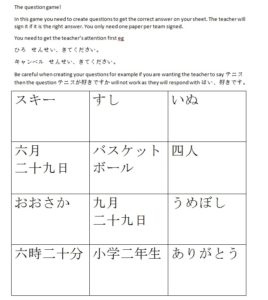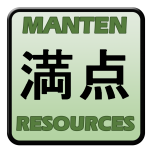If you are looking for a exciting way to have students practice making questions then look no further than “the question game”. It is free and fun but also ticks the boxes of differentiation and developing growth mindset and teamwork skills.
How to play
This is a great game to play when you have a practicum student or a Japanese assistant. You will need to know a little about the person to make the worksheet. The worksheet can be 3 by 3 squares or larger depending on how long you want the game to take. In each box, write in Japanese a word or phrase. The students will need to look at the words or statements on the sheet and think of a question or statement or action that will make you say that word or phrase. As such, pitch the stimulus phrases to their current ability level.
The idea is that the students are seated in groups at tables with a copy of the worksheet each, plus one team copy that they will use to get signed by the teachers.
When they have thought of a question they call, either you or the assistant over by name, using phrases such as “Campbell せんせい、きてください”. This is good for less confident speakers as they have to say it many times and get quite good at it.
When you come they will ask you the question but the fun part is their question may be grammatically correct but needs to be asked to the other teacher. Eg our assistant liked basketball so asking me 「好きなスポーツは何ですか。」 wouldn’t work. They love it when this happens and are frantic to ask the question again to the right person.
The more they have to think, the more fun they have. For eg I put in the example below the grade my son is in in primary school. They had to think about me and what they knew about my family to generate a good question. (Click on the image to see it in more detail)
The best stimulus phrase though is 「ありがとう」. This can lead to a wide range of responses from compliments about how much they love you to offering you a seat. One time when we played this, a particular group became stuck on this question. The quick thinking Japanese assistant, seeing their dilemma, dropped his pencil intentionally. The boys picked it up for him and said 「どうぞ」 eliciting the 「ありがとう」 they had been searching for.
Why this game works
I love this game because it naturally differentiates and enables all students to utilise higher order thinking skills regardless of their Japanese ability. Students develop teamwork skills as they work together to translate the stimulus word or phrase, consider options that may elicit the correct response considering their knowledge of the person and/or Japanese culture, and translate these questions into correct Japanese. It develops growth mindset skills as students ask the wrong questions and consider new possibilities. It acknowledges social constructivism theory as it encourages students of varying abilities to work together, learn from each other and consider other ways of arriving at an answer. It is also very flexible and the same question sheet could be used by various classes with only the questions changing.
How to mix it up
Idea 1 : You can make it specific to a grammatical structure you want to practice by including more specific phrases such as「はい、行ったことがあります。」when you want to practice questions like 「日本に行ったことがありますか。」. If you want to keep it more general, use instead a phrase like 「はい、あります。」as your stimulus. This could lead to other options such as 「自分の部屋にテレビがありますか」.
Idea 2 : You could test cultural knowledge using the target language via this game. For example your stimulus could be a date eg 「三月三日」which would elicit questions like 「ホワイトデーはいつですか」. Or it could be a specific cultural term eg 「ちゃんこなべ」which would elicit questions like「すもうさんは何を食べますか。」.
Further reading:
You may also be interested in our post on growth mindset at https://www.mantenresources.com.au/teachers/blog/growth-mindset-more-than-just-a-poster-on-the-wall/

